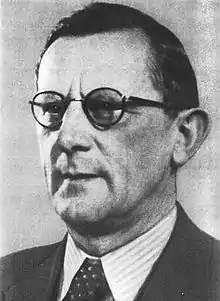
Alfred Kästner (12 December 1882 – 12 April 1945) was a German communist and resistance fighter against Nazism.
Biography
Kästner was born in Leipzig. He was a wood merchant by profession, and a member of the Spartacus League. In November 1918, during the German Revolution, he was elected to the Leipzig Workers' and Soldiers' Council. Kästner was also a founding member of the Leipzig branch of the Communist Party of Germany (KPD) in 1919. When the KPD was banned in 1923–1924, underground meetings were held in Kästner's office.
After the Nazi Party came to power in 1933, Kästner's office was once again used for underground gatherings of KPD activists from Leipzig as well as nearby towns such as Chemnitz, Dresden and Riesa, and for printing illegal pamphlets.
Kästner was arrested in September 1933; although he was sentenced to two years and eight months' imprisonment, he was interned in the concentration camps Sachsenburg, Sachsenhausen and Buchenwald until 1939.[1]
After his release, Kästner joined the resistance group around Georg Schumann and maintained contact with resistance fighters in Hamburg, Bavaria and Württemberg.
Kästner was arrested again by the Gestapo on 11 March 1945. He was shot to death by the SS in Lindenthal, northwest of Leipzig, and thrown in a pit together with 52 other German and foreign anti-fascists on 12 April 1945, just a week before the U.S. Army entered Leipzig.[2]
The street in the Südvorstadt borough of Leipzig where Alfred Kästner lived was renamed Alfred-Kästner-Straße on 1 August 1945.[3]
References
- ↑ Ilse Krause (1960). Die Schumann-Engert-Kresse-Gruppe: Dokumente und Materialien des illegalen antifaschistischen Kampfes (Leipzig, 1943 bis 1945). p. 96.
Im September 1933 verhaftete die Gestapo Alfred Kästner zusammen mit seiner Familie. Er verriet keinen seiner Genossen. Während die Gestapo nach einigen Wochen seine Familienangehörigen entließ, wurde er nach 20 Monaten Untersuchungshaft, die mit qualvollen Mißhandlungen verbunden war, zu zwei Jahren und acht Monaten Zuchthaus verurteilt. Anschließend schleppten ihn die Faschisten durch die Konzentrationslager Sachsenburg, Sachsenhausen und Buchenwald. Die schweren Mißhandlungen hinderten ihn nicht, nach seiner Entlassung im Jahre 1939 die politische Arbeit wieder aufzunehmen.
- ↑ "Leipziger Arbeiterbewegung: Alfred Kästner". DKP Leipzig. Archived from the original on 10 September 2016. Retrieved 28 February 2018.
- ↑ "Alfred-Kästner-Straße". Leipzig Lexikon. Retrieved 28 February 2018.